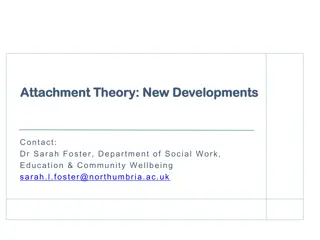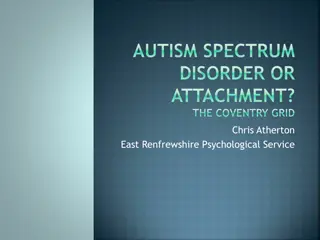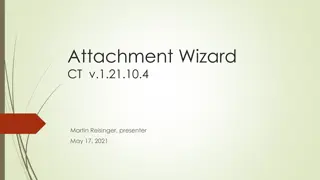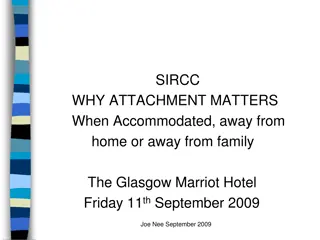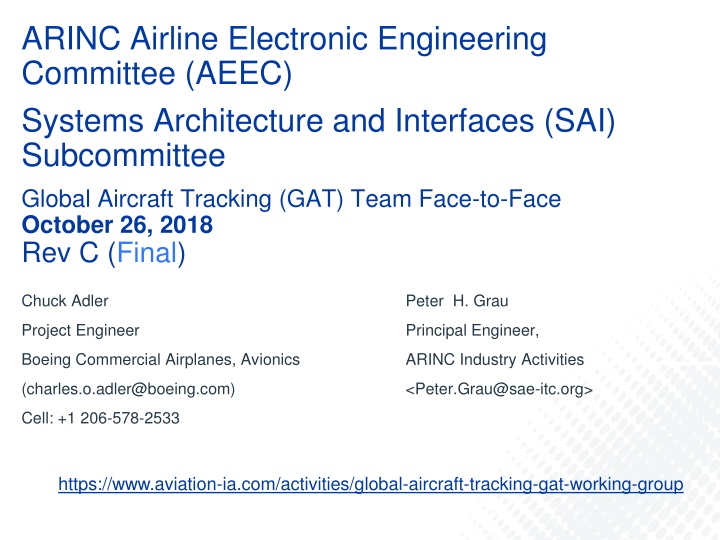
ARINC Airline Electronic Engineering Committee GAT Team Meeting
"Explore the details of the ARINC Airline Electronic Engineering Committee Systems Architecture and Interfaces Subcommittee's Global Aircraft Tracking Team face-to-face meeting. Dive into discussions on aircraft tracking technologies, regulatory updates, and work sessions. Stay informed about upcoming meeting schedules and major milestones in the aviation industry."
Download Presentation

Please find below an Image/Link to download the presentation.
The content on the website is provided AS IS for your information and personal use only. It may not be sold, licensed, or shared on other websites without obtaining consent from the author. If you encounter any issues during the download, it is possible that the publisher has removed the file from their server.
You are allowed to download the files provided on this website for personal or commercial use, subject to the condition that they are used lawfully. All files are the property of their respective owners.
The content on the website is provided AS IS for your information and personal use only. It may not be sold, licensed, or shared on other websites without obtaining consent from the author.
E N D
Presentation Transcript
ARINC Airline Electronic Engineering Committee (AEEC) Systems Architecture and Interfaces (SAI) Subcommittee Global Aircraft Tracking (GAT) Team Face-to-Face October 26, 2018 Rev C (Final) Chuck Adler Peter H. Grau Project Engineer Principal Engineer, Boeing Commercial Airplanes, Avionics ARINC Industry Activities (charles.o.adler@boeing.com) <Peter.Grau@sae-itc.org> Cell: +1 206-578-2533 https://www.aviation-ia.com/activities/global-aircraft-tracking-gat-working-group
October Face-to-Face Schedule/Agenda GAT Day 1 Wednesday Oct 24 GAT Day 2 Thursday Oct 25 GAT Day 3 Friday Oct 25 Time (Honolulu Time) (start time) Main Track (ADT) TRFD Track Main Track (ADT) TRFD Track Main Track TRFD Track GAT and Joint GAT/TRFD sessions: Main Room TRFD breakout sessions: Main Room - Breakout area Notes 8:00 meeting prep time meeting prep time meeting prep time 8:30 intro/planning/coord (30 min) intro/planning/coord (15 min) intro/planning/coord (30 min) 9:00 9:30 Hawaiian Air view/use of GADSS Tracking 10:00 ADT Interfaces working session TRFD Team Working Session Breakout ADT Interfaces working session 10:30 ADT Interfaces working session 11:00 The Use of Telemetry for Flight Operations: Lessons from Space Operations (30 min presentation/15min discussion/Q&A) and Use of Inmarsat Broadband Safety Services for Aircraft Tracking (15 min) 11:30 Regulatory Updates/Discussion (TBD) 12:00 Lunch 12:30 Lunch Lunch 13:00 Joint TRFD Requirements and Architecture Update and Discussions 13:30 Paumalu Satellite Access Station Tour (1 hour transit each way - participant cars/carpools) 14:00 ADT Interfaces working session Notes from Hannes: Here is a link to the Inmarsat facility: https://goo.gl/maps/WLxFDZTyY7J2 Sat nav entry is Comsat Rd., Hale iwa There is only one Comsat Road: we drive past the residential area up to the access gate and from there on out it s one- dimensional: follow the winding road until you get to the satellite dishes. Report 680 Draft 3 Working session (ELT, DAL, Nuisance Alert) 14:30 TRFD Team Working Session Breakout 15:00 15:30 Report 680 Draft 3 Working session ("Hyrbid" ELT defintion) Plans/Around the Room 16:00 16:30
Meeting Material on Sharepoint GAT -> 680 Input -> 17.) Meeting Archives -> 2018-10 Honolulu Meeting
Upcoming Meeting Schedules/2018/2019 Look-Ahead FEDEX SAI+GAT Memphis., TN Kelowna, BC Inmarsat London Oct 24-26 APR 10,11,12 TRFD REQ Start ARINC 680 Submitted to ARINC JAN 2019 Iridium WA DC Area (Leesburg, VA), Skytrac Inmarsat Hawaii (Honolulu area) GAT JUNE 11-13 Major Meetings or Milestones August 21,22,23 Dec 4, 5, 6 (+7) IQPC - 2th Flight Location and Data Recovery 11- 13 September 2018 - Hamburg, Germany EASA Aircraft In Distress End Users Workshop 2018 EASA Location Of Aircraft In Distress Enablers Workshop 9/10 Cologne, Germany NEW MAR APR MAY JUN JUL AUG SEPT OCT NOV DEC JAN TRFD ARCH Start TRFD Strawhorse #1 February (following FL meeting) APR 23-26 TRFD REQ Finish AEEC Mid-Term SESSION (10/14) Characteristic Start See following slide for notes AEEC GEN SESSION Dallas Tx MAR APR MAY JUN JUL AUG SEPT OCT NOV DEC JAN FEB GAT WG will present one completed document for approval at the General Session in April 2019 (in Prague). ARINC 680 ADT Interface Standards Section Integration and refinement, SAI, external reviews common interface list, draft straw horse and assumptions Interface refinement, by-architecture scrubs/discussion and cross architecture integration SAE/ARIN C edit and Release Integration and refinement draft 3 to AEEC TBD: Proposed to move to after WA DC face-to-face meeting Final draft draft 2 to AEEC 10/8 MAR APR MAY JUN JUL AUG Review updates, Doc 10054, updates Gen edit/arch updates ARINC 680 ADT Requirements and Architecture Report Sections Team reviews, integration and refinement 2019 meeting plan: 1.) February co-located SAI-GAT: 4-6 GAT, Feb 7-8 SAI: Coral Gables Florida, USA, Gables Engineering 2.) April,: GAT only meeting: April 2-4, Pretoria/Johannesburg area, South Africa: SatAuth 3.) June co-located SAI-GAT: June 17-19 GAT, June 20-21 SAI: Toulouse France, Airbus 4.) August GAT only - Boeing Seattle Final updates, team edits, SAI edits/input Strawhorse updates Draft 1 to AEEC
AEEC Mid-Term Session Notes Notes from Paul Prisaznuk: clear support for proposal to prepare ARINC Project Paper 681: Guidance for the Timely Recovery of Flight Data (TRFD) as a single document (containing Requirements, Architectures, Interfaces, Recommendations, etc). There was one discussion pertaining to ARINC Project Paper 680: Autonomous Distress Tracking (ADT). Though January 2019 was reported as date of maturity, the document will be open for comment until approval in April. Therefore, I would anticipate a few changes before the final-final draft is released. February 5-7 meeting in Coral Gables may result in a few changes, final inputs from industry by March 1 for planned release in mid-March, and approval on April 30, 2019 at AEEC General Session in Prague. Related - AEEC has expressed desire for GADSS Symposium, similar to Milwaukee symposium, April 30 in Prague. Jessie has agreed to lead the symposium. Also proposal to use the next IATA Safety and Flight Operations Conference (SFO) planned beginning April (2nd-4th) In Barcelona to provide Airlines with a status on AEEC GAT activities on ADT (and TFRD) .
ADT Interfaces Straw Horse Current Status Interfaces version worked during meeting: GAT -> 680 Input -> 16.) ADT Interfaces and ARINC 429 Labels/ -> Strawhorse Interface Definitions -> Current Working Version -> Interface definitions (version 2m).xls Interface Identity Tag TRS_M #1 TRS_M #2 Status Interface Identity Tag ADT_M #1 ADT_M #2 Status Name Notes Name Notes (A680 Draft 2) GEN GEN (A680 Draft 2) GEN GEN Aircraft Power Resilient Power Aircraft Power Aircraft Status Data A429 complete, discrete to be investigated A429 complete, discrete to be investigated TRS_M #3 Transmitter Module Status ADT_M #3 Transmitter Module Status WORK REQUIRED GEN GEN WORK REQUIRED GEN TRS_M #4 TRS_M #5 Manual Command Flight Crew Feedback ADT_M #4 ADT Module Status A429 complete, discrete to be investigated A429 complete, discrete to be investigated ADT_M #5 Triggering Command TRS_M #6 Triggering Command WORK REQUIRED GEN NA NA NA NA GEN GEN WORK REQUIRED WORK REQUIRED WORK REQUIRED WORK REQUIRED WORK REQUIRED GEN GEN GEN NA NA NA NA WORK REQUIRED WORK REQUIRED WORK REQUIRED WORK REQUIRED WORK REQUIRED ADT_M #6 ADT_M #7 ADT_M #8 ADT_M #9 ADT_M #10 ADT_M #11 ADT_M #12 ADT_M #13 ADT_M #14 ADT_M #15 ADT_M #16 Position Data Maintenance Command Maintenance Data SW/Config Upload SW/Config Reporting Manual Command Flight Crew Feedback Physical mounting interface Physical volume constraints Cooling air interface Grounding and Bonding TRS_M #7 TRS_M #8 TRS_M #9 TRS_M #10 TRS_M #11 TRS_M #12 TRS_M #13 TRS_M #14 TRS_M #15 TRS_M #16 TRS_M #17 TRS_M #18 Position Data Distress Tracking Signal Ground Command Maintenance Command Maintenance Data SW/Config Upload SW/Config Reporting Enable/Disable command Physical mounting interface Physical volume constraints Cooling air interface Grounding and Bonding Status Key WORK REQUIRED NA GEN FINAL Not worked in detail yet or in-work Not applicable for standardizing Generic/Strawhorse definition finalized By Architecture Reviews/Updates completed 10/26 notes: see following page
ADT Interfaces Straw Horse Current Status 10/24-10/26 notes: See: Straw Horse Dimensions ADT Unit(s) Overhead Mount REV B.docx and Physical Interface Requirements ADT Transmitter.pptx for proposed straw horse for scrubbing by architecture teams Proposed interface additions/changes: 1. Antenna footprint: scenario common footprint that fits multiple antennas, OEMs can drill into airframe, if not used (expected to be minority of the cases) then a cover plate is used to seal. 2. ADT Transmitter connector (proposed common mates with interface and major pin definitions to standardize installation wiring) 3. Proposal to n/a ADT computer physical interfaces the expected common approaches for ADT computer implementation are to host this in existing systems for which these would not apply or to implement an integrated ADT Computer, ADT Transmitter unit, in which case the ADT transmitter unit physical interfaces would apply (we need a note to reflect this). Next steps: 1.) Timing goal for volume and footprint proposals have in well developed form prior to December meeting 2.) Boeing will add max height dimension (added to REV B), connector, and antenna footprint goals 3.) Embraer and Bombardier inputs if available 4.) Start cross OEM table and look for commonalities 5.) By architecture team (ELT and Iridium) review and response to strawhorse antenna footprints with what is realistic from supplier/development perspective (Vijay and Jon Iridium, Tom ELT architectures) 6.) By architecture team (ELT and Iridium) review and response to strawhorse transmitter unit footprints with what is realistic from supplier/development perspective (Vijay Iridium, Tom ELT architectures) 7.) ELT team to define different ELT options wrt to ED-62B (e.g.what is a hybrid, what are different versions of this?) see C/S requirements on following page: conclusion report and team will follow existing C/S and ED-62B conventions: ELT (AF), ELT (AD), ELT (DT), ELT (DT) with crash survivability. Scope and intention of physical interface recommendations: 1.) The intent for these physical interface recommendations is to provide guidance on physical constraints where these do not already exist, if an architecture implementation is using current specs (e.g. ARINC 771, 781) then these interfaces would be n/a for that architecture in the A680 with a reference to the spec used. If an architecture is implemented in existing units (e.g. Inmarsat satcom, ADS-B Out architectures) then interfaces are be n/a . If architecture specific team decides that due to variability etc this is not practical or is not useful then this could be n/a for that architecture (physical interfaces for other architectures could still provide useful guidance in this case for individual developers or implementers looking for such guidance).
C/S: Crash Survivable ELT (DT) Definition from C/S T.001: ELT(DT)s Specifically Designed to Withstand a Crash Impact 4.5.10.1 Introduction Potentially there may be ELT(DT)s that have additional functionality, as defined by National Adminsitrations and/or Aviation Authorities, which are designed to: 1) function both prior to a crash and after a crash, and withstand crash impact conditions; 2) be activated in-flight or by crash; 3) have homing and locating signals; and/or 4) have extended operating life. If there is a conflict between the requirements of this section and any other section of this document, then this section takes precedence. 4.5.10.2 Beacon Hex ID The Hex ID of the ELT(DT) shall not change from when activated in flight compared to when operating after a crash. 4.5.10.3 Burst Repetition Period (with Crash Detection) If the ELT(DT) includes a crash detection function, within 5 seconds of a crash the ELT(DT) shall restart the transmission schedule for an ELT(DT) as if the ELT(DT) had just been activated. 4.5.10.4 Duration of Continuous Operation The minimum duration of continuous operation for this type of ELT(DT) shall be at least 24 hours at any temperature throughout the specified operating temperature range. This is to be understood to mean the total operating time which is a combination of the time prior to a crash and post-crash. 4.5.10.5 Homing and Locating Signals The inclusion or otherwise of one or more homing signals in the ELT(DT) and the activation and duration of any homing signal transmissions are the responsibility of national administrations.
EASA Material on Sharepoint GAT -> 680 Input -> 02.) References (ICAO GADSS CONOPS etc.) -> EASA -> 2018-09-27 EASA Material
Risks, Recommendations for team review/discussion 1.) The possibly largest risk faced in ADT implementation is the potential split between EASA and ICAO requirements and timelines: The EASA requirements are potentially significantly more rigorous than the ICAO requirements (DAL C, Crash Survivability) and potentially have an implementation date of 2023. The ICAO SARPS do not include these requirements but are likely to hold to the 2021 implementation date. The industry will be very hard pressed (resource wise and in an economically feasible manner) to develop a set of ICAO compliant systems for 2021 and then a set of EASA compliant systems for 2023. This effectively could result in a need to effectively develop EASA compliant system to the ICAO SARPS timeline which is extremely challenging and is probably not realistic. CPO-17: The design reliability of the airborne equipment used by the system should be such that the rate of nuisance activations (disregarding manual activations) is less than 2E-5/FH (corresponding to Major severity classification). 5. CPO-17: does this imply a DAL and which one? a. Post-meeting: the DAL should be commensurate to the nuisance rate objective i.e. DAL C. b. Note: this DAL only is applicable to those components which contribute to the nuisance rate, and the design of the LAD system may foresee an architecture where the transmission is of a lower DAL (DAL D). Discussion and recommendation on the application of DAL level to the distress logic nuisance alert rate requirement. Background: The ED-237 MASPs does not use the term Major with respect to the nuisance alert rate. ED-237 focuses on the SAR preferred 2x10^-5/FH rate and a logic contribution rate of less than 1x10^-5/FH and intentionally stayed away from discussing or applying a DAL level to either the system or the logic as outside of the scope of the document as this should be determined by the airplane level hazard assessment. In the draft CPOs and following discussions there has been an evolution of the requirement of1x10^-5/FH for the logic to a major level classification (CPO-17) to a DAL C expectation (follow-on discussions). Our recommendation is not to increase the existing DAL levels and maintain a focus on the achieving the required nuisance alert rate: 1.) The DAL Level should be out of the scope of this requirement and should be determined by the airplane level hazard assessment (This situation is similar to the current approach taken for SATCOM systems which are DAL level D). 2.) The current ELT is a Minor level specification (and understood by industry as a DAL D device) and this should be maintained for the ADT transmitter functionality (for example the ELT (DT)). 3.) The focus should be maintained on ensuring that the distress logic meets the required nuisance rate; focusing resources on rigorous analysis of logic (e.g. FMEA) and use of simulations and other means to validate the logic within representative environments will be a much more effective application of effort than the application of more general process associated with a higher DAL.
Document 680 Draft 2 Release/Draft 3 Plans A680 Draft 3 on the Sharepoint GAT -> 680 Input -> 04.) ADT Requirements and Architectures Report -> Draft 03 A680 Base Document Draft 3 Start.doc (same as A680 Base Document Draft 2.doc above) Copy start document, makes changes with changes tracked, avoid section replacements unless absolutely needed send updates (as marked up document or notes) to Chuck for incorporation into master (updates will be posted periodically similar to draft 2) Updates proposed for Draft 3 (Nov/Dec timeframe) 1.) additional internal/external inputs incorporated 2.) further clean-up/editing 3.) all interface at generic/strawhorse level, majority at by architecture reviews complete 4.) summary of draft EASA CPOs with high level discussion (requirements section), EASA schedule 5.) EU TCO summary 6.) refined summary and conclusions (near final) 7.) inputs from recent discussions a.) power duration update, including Cospas-Sarsat requirements, survey of avherald data b.) operator perspective (from Norlinor discussion, slides)(in airplane integration section)? c.) nuisance rate discussion 8.) ADS-B updates (Jessie s working paper proposals etc )(see 10/10 notes for details) 9.) Other? Look Ahead updates proposed for Final draft (Jan timeframe) 1.) additional internal/external inputs incorporated 2.) ELT ED-62 (for final draft) sync with as-released ED-62 3.) Updates to reflect any EASA releases 4.) Updates to reflect any ICAO material (10054 updates/releases etc..)
Around the Room Ruben: https://www.skytrac.ca/utair-airlines-selects-skytrac-gadss/ Utair Airlines Selects SKYTRAC Flight Monitoring for GADSS Compliance These configurations will maintain existing ELT (AF) and include autonomous capabilities and other relevant capabilities such as flight deck voice connectivity.


